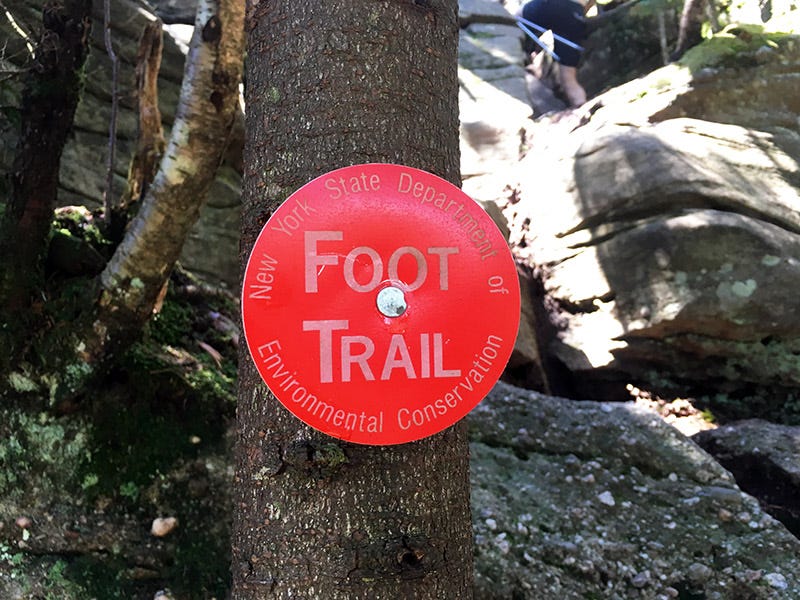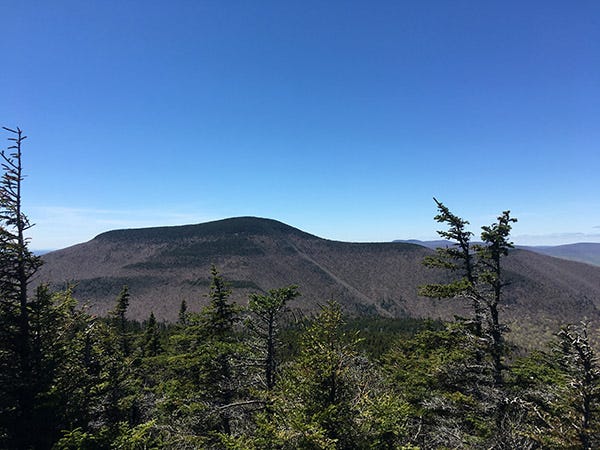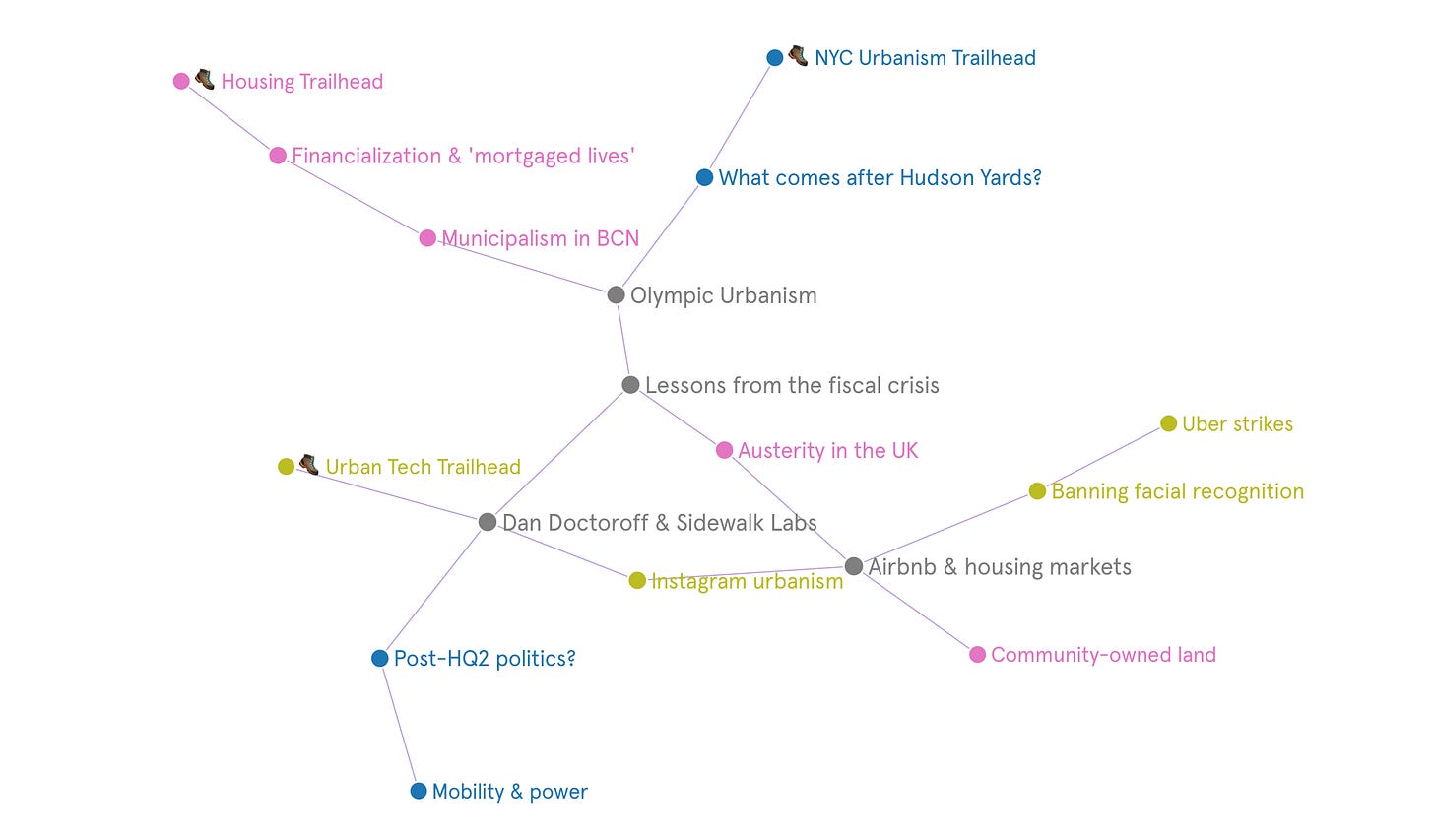Learning Trails

Hello! I’ve been thinking lately about the ways that people externalize their learning.
This isn’t something that usually preoccupies me too much. I have my rituals, sure: I save articles to Instapaper, I make channels on Are.na, I take notes by hand. But I don’t really have a practice of consuming information and then representing it. Since I’ve been bookmarking interesting examples as I come across them, I thought I’d send you all a few.

Tom Critchlow wrote a post a couple weeks ago about blogchains, an idea that Venkatesh Rao coined to describe his writing on Ribbonfarm. It’s simple: he writes a series of short posts on one topic and links them together in a sequence.
Venkatesh’s blogchains (above) are ways of visualizing and extending his thinking about still-fuzzy ideas, like “domestic cozy.” They might meander in one direction and then another. They are a lightweight way of publishing a train of thought. Tom is also organizing some of his writing into blogchains, too. I suppose a lot of writing projects are blogchains without realizing it — like Hubert Horan’s unhinged 20-part series, which I linked to a few weeks back, called “Can Uber Ever Deliver?”
I like this idea because it’s not really a new tool or feature. It’s just an invitation to view your ideas in a certain way. It’s a frame that imposes structure in one sense, so that you can preserve openness in another.

I use Are.na for a related, but different type of visualization. I gather readings and other sources of information rather than snippets of my own expression. So instead of channels collecting my thoughts, it’s more that channels are my thoughts. Each one reflects what I’m synthesizing from the contents (which are often other people’s ideas).
You don’t have to use Are.na to get this effect. Édouard Urcades wrote a very nice post where he describes theprocess more generally as building “reading networks.”
While texts often build and maintain an internal and pre-set collection of references …, it’s a far more personal practice to form one’s own links in an inter-textual manner.
I’d like to think that building your own reading networks can foster a method of building personal abstractions, building personal relevance to any given topic, and improving the methods by which you consume others’ ideas and structures.
I love how Éd’s writing rhymes with the way Octavia Butler once described her own reading practices:
“I generally have four or five books open around the house—I live alone; I can do this—and they are not books on the same subject. They don't relate to each other in any particular way, and the ideas they present bounce off one another. And I like this effect. I also listen to audio-books, and I'll go out for my morning walk with tapes from two very different audio-books, and let those ideas bounce off each other, simmer, reproduce in some odd way, so that I come up with ideas that I might not have come up with if I had simply stuck to one book until I was done with it and then gone and picked up another.
So, I guess, in that way, I'm using a kind of primitive hypertext.”

One time someone commented that Are.na was like an incomplete version of the detective’s cork board from a crime show. You can lay out all your pieces of evidence, but there’s no red thread to map out the connections between them.
I still think about that comment all the time. I think it gets to the difference between a channel and a blogchain, and the different qualities of thought I’m looking to make space to inhabit online. If a channel is a map, you still need a way to make a journey. A trail, let’s say.
The map is structural, synoptic, and independent from time; the trail is intuitive, temporal, and constrained. A blogchain is one form of thinking trail, but there are many others.
The unfolding-through-time is I what like best about the idea of a trail. The imminence of thought taking concrete shape. In other words: “the road is made by walking.”
Or, as Laurel Schwulst writes:
“Snails (and other gastropods like slugs) excrete slime. They make this slime to move, so that their bodies don’t lose moisture to the rugged terrain beneath them. This slime is beautiful because it glimmers. It’s also beautiful because it’s a map of time recently spent by the snail. Where is the snail now? And where was it going in the first place?”
Another thing I like about the trail image is the wilderness (if we can call it that). When you make a trail you are charting a small path, moment by moment, through infinitude. You step here and not there. Even following an established trail means hewing to this original concession, which if you think about it, is a collective decision about how to spend our time.
Given the sheer volume of content that fills digital spaces, we might think about attention using metaphors of environmental stewardship: building trails, remediating damaged landscapes, prescribing burns, packing out our trash.
I only just started Jenny Odell’s book, How to Do Nothing, but it’s thick with this kind of attention to place. Laurel’s app Flight Simulator (an “ode to airplane mode”) also helps me get into this frame of mind, because its poetic devices play with time and space. First you choose your flight and then you fill that virtual journey with the trail of thinking you’ve set aside time to complete.
Craig Mod’s practice of walking, and the various experiments he’s published from the trail, are even more literal examples. Like this spring, when he texted one image per day to everyone who signed up — and then published a single book of their SMS responses.
He’s committed to the idea of walking because it’s already at the core of everyday life:
By even just using the word “hike,” folks drop off: Not young enough, not strong enough, not ready for the bugs. You can trick a person into hiking by calling it a walk. I’ve done so many times. And “walk” denotes a thing to be easily grabbed. A walk is there to be taken.
If I’m going to constrain my use of social media, or try to trace the thread of an idea to the exclusion of all the other noise in my head, I’d like to follow a process as simple and emergent as that. To walk and notice and think — and put the pieces together in a similar headspace.

I’ll leave you with an attempt to bridge the divide between the map and the journey: this little trail network diagram I made to document some of the ideas I’ve talked about so far on the newsletter. Some waypoints are actual emails, others are just curiosities for now. Making it brought back memories of thecomputer game Escape Velocity, where you have to plot your course between star systems. Who knows which paths will be taken, which will be constructed and which left to seed.
Happy trails,
Leo
